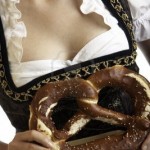Oktoberfest is drawing nigh (more quickly, actually, than October itself—the Munich festival begins next weekend), and though the most celebrated element of the festival is beer, I thought it might be worth delving into the history of another essential feature of both German and American festivities. “The crossbow competition?” you may ask. “The pork knuckles? The traditional hat sporting tufts of goat hair?” These are all good guesses. But in fact, I wish to focus your attention on the story of the pretzel.
Almost every fact in the pretzel’s twisted past (yes, I know–sorry) is up for debate. Though pretzels probably have their roots in the hard-baked biscuits that the Roman army carried into battle, the first of the familiar salted, knotted variety probably emerged on the European scene sometime in the 7th century, perhaps in conjunction with an egg-less Lent. The history, however, has become a little muddled, not least because Flemish painters saw pretzels as so fundamental that they painted them into depictions of the Last Supper. Confusing though this anachronistic tendency may be, I sort of appreciate their thinking: “If I like pretzels, who am I to deprive Jesus of a little nosh?”
Even the origins of the name are open to debate, with one camp (let’s call them the jewelry camp) saying that it comes from a Latin word for “bracelet” and another (let’s call them the pretzel fetishists) saying that it comes from the Latin word for “reward.” Continue reading

